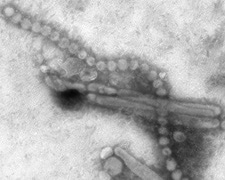NOTE: THIS IS AN OLD ARTICLE I PUBLISHED AND POSTED ON AUGUST 25, 2013. THERE ARE CASES THAT CAN RE-OCCUR AT DIFFERENT TIME AND PLACE/COUNTRY. THAT IS WHY I RE-POST THIS AGAIN.
 |
| photo credit: naomispenny.blogspot.com and www.cdc.gov |
A new strain of bird flu that can infect and kill animals has been discovered in chickens in poultry markets in China, according to a new study published on Wednesday in the journal Nature.
Having studied samples from birds for the H7N9 virus, researchers at the University of Hong Kong said genetic tests suggested the virus entered domestic ducks from wild birds and then infected chickens, which are probably the origin of infection to humans.
The research team also discovered a new virus called H7N7 in chickens. Lab tests showed H7N7 was also able to cause severe pneumonia in ferrets, which are usually used as proxies for humans in flu research.
Zhu Huachen, one of the leading authors of the paper, told Xinhua that H7 viruses probably transferred from ducks to chickens on at least two independent occasions and that reassortment with H9N2 viruses generated the H7N9 outbreak lineage.
Although the H7N7 viruses carry only some of the molecular markers present in the human H7N9 isolates, the authors suggested the current pandemic threat could extend beyond H7N9 viruses, and that long-term influenza surveillance was essential for early warning of new viruses and interspecies transmission events.
H7N9 bird flu has killed 45 people on the Chinese mainland since the first human infection was confirmed in late March, a health official said last week..
credit/source: http://www.china.org.cn/china/2013-08/22/content_29789780.htm
Click for complete details I have another article posted last April 29, 2013:
http://naomispenny.blogspot.com/2013/04/influenza-type-viruses-and-subtypes.html#.Uhhg0tI3D0E
Health- Seasonal Influenza(H7N9), Influenza Type A Viruses and Subtypes and People Should Get or Not Receive The Flu Shot(TIV)
Background: Human Cases of H7N7 Infection in The Netherlands
Since the end of February 2003, the Netherlands has been reporting outbreaks of highly pathogenic avian influenza A (H7N7) in poultry on several farms. More recently, there have been reports of H7N7 infections among pigs and humans in the Netherlands, and among birds in Belgium and Germany. While it is unusual for people to get influenza infections directly from animals, sporadic human infections and limited outbreaks caused by avian influenza A viruses, including H7N7, have been reported. When such infections are identified, public health authorities monitor the situation closely. Because influenza H7N7 viruses do not commonly infect humans, there is little or no antibody protection against these viruses in the human population. If an avian or other animal influenza virus is able to infect people, cause illness, and spread efficiently from person to person, an influenza pandemic could begin. Additional information on human infections with avian influenza viruses can be found here.
As of April 25, 2003, the National Influenza Center in The Netherlands reported that 83 confirmed cases of human H7N7 influenza virus infections had occurred among poultry workers and their families since the H7N7 outbreak began in chickens at the end of February 2003. The vast majority (79) of these people had conjunctivitis, and 6 of those with conjunctivitis also reported influenza-like illness (ILI) symptoms (e.g., fever, cough, muscle aches). One person had ILI only (no conjunctivitis) and 2 persons had mild illness that could not be classified as ILI or conjunctivitis. In addition, one individual, a 57-year-old veterinarian who visited one of the affected farms in early April, died on April 17 of acute respiratory distress syndrome (ARDS) and related complications from H7N7 infection. Dutch authorities have reported evidence of possible transmission of H7N7 influenza from 2 poultry workers to 3 family members. All 3 family members had conjunctivitis and one also had ILI.
Public Health Monitoring
CDC is in communication with public health officials in the Netherlands and the World Health Organization (WHO) regarding the recent human cases of influenza A (H7N7) illness in the Netherlands and will continue to monitor the situation. CDC has begun production of a reagent kit that would allow laboratories to identify influenza A (H7N7) viruses. To enhance timely detection of any additional human influenza cases due to these viruses, WHO recommends that affected countries conduct enhanced surveillance for influenza among humans and animals and conduct studies to better understand possible transmission patterns. CDC and WHO have issued no restrictions on travel to the Netherlands. Additional information from WHO can be found at http://www.who.int/csr/don/2003_04_24/en/.
Influenza in the United States
Influenza activity in the United States is at low levels. Influenza A (H1N1), A (H1N2), A (H3N2), and influenza B viruses have been identified in the United States during the 2002-03 season and have been well matched by the current influenza vaccine. The current vaccine does not protect against infection with the influenza A (H7N7) virus. U.S. residents who are traveling outside the United States should consult their physician for advice about whether they should be vaccinated against influenza and about the use of influenza antiviral medications.
This website is archived and is no longer being maintained or updated. For updated information on avian influenza, see the CDC Avian Influenza website and the World Health Organization (WHO) Avian Influenza Situation Update page.
Page last modified May 20, 2003
http://naomispenny.blogspot.com/2013/04/influenza-type-viruses-and-subtypes.html#.Uhhg0tI3D0E
naomispenny.blogspot.com published on April 29, 2013
http://naomispenny.blogspot.com/2013/04/influenza-type-viruses-and-subtypes.html#.Uhhg0tI3D0E
naomispenny.blogspot.com published on April 29, 2013